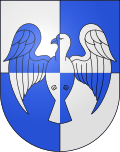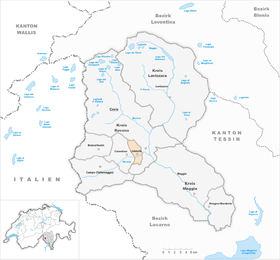Linescio
| Linescio | |
|---|---|
| State : |
|
| Canton : |
|
| District : | Vallemaggia district |
| Circle : | Rovana district |
| BFS no. : | 5315 |
| Postal code : | 6682 |
| Coordinates : | 688 232 / 129154 |
| Height : | 668 m above sea level M. |
| Height range : | 483–2446 m above sea level M. |
| Area : | 6.66 km² |
| Residents: | 48 (December 31, 2018) |
| Population density : | 7 inhabitants per km² |
| Location of the municipality | |
Linescio , in alpine Lombard dialect Lünèsc, Linesc [lynɛʃ, lineʃ] , is a municipality in the county Rovana , vallemaggia , in the Swiss canton of Ticino .
geography
The place is 668 m above sea level. M. on the rocks on the left side of the Rovana , 26 km northwest of Locarno . The western boundary of the municipality leads from Madone di Camedo (2,446 m above sea level) in a slightly southeastern direction - mostly along the Ri di Fraccia stream - down to Rovana. After crossing it, it goes in a southwest curve up to Pizzo Sascola (2057 m above sea level). Down the eastern slope it meets the hamlet of Rotanda (1268 m above sea level) and leads north back to Rovana. After crossing it, it leads shortly to the northeast before it takes a north-westerly direction up to the Costone di Camedo (2121 m above sea level). From there, the short northern border leads west back to Madone di Camedo. The main settlements are lined up on the road from Cevio towards Cimalmotto (municipality of Campo (Vallemaggia) ) and are from east to west Ponte Asciutto (708 m above sea level), Linescio di Fuori (700 m above sea level), Linescio (- Dorf) (664 m above sea level) and Linescio di Dentro (677 m above sea level).
Above these districts are the hamlets of Bolla (1020 m above sea level) and Monte (1093 m above sea level). The only noteworthy settlement of the municipality on the right bank of the Rovana is Faido (700 m above sea level). But there are other groups of houses and single farms. Apart from the main settlement, the hamlets are mostly Alps, which are not inhabited all year round. Of the total municipal area of 658 hectares, only 1.5% is agricultural land and 1.2% is settlement area. Almost two thirds of the municipality, exactly 65.6%, are covered by forest and wood and 31.7% are unproductive areas (mostly mountains).
Neighboring communities are Cevio and Cerentino .
history
The village is first attested to in 1437 as Lignazio .
The community has only been independent since 1858. Before that she belonged to Cevio .
population
| Population development | |||||||||||||
|---|---|---|---|---|---|---|---|---|---|---|---|---|---|
| year | 1860 | 1870 | 1900 | 1941 | 1950 | 1960 | 2000 | 1970 | 1990 | 2000 | 2010 | 2018 | |
| Residents | 243 | 265 | 220 | 142 | 139 | 107 | 83 | 53 | 32 | 32 | 48 | 48 | |
development
Despite the limited cultivation area, the place grew to 265 residents by 1870. Then began the overseas emigration to California and Australia. The large population decline continued until the recent past (1870–2000: −87.9%). The first wave of emigration (1860–1939) led overseas, the second (since 1950) to the urban regions of Ticino. In recent years, however, a few people have migrated, so that the low point in the number of inhabitants seems to have been overcome for the time being.
languages
The long-established population speaks a Lombard dialect, which is very different from the standard Italian language. In the last census, Italian was named as the main language by 81.25% (1970 93.98%). Due to the emigration of the natives and the immigration of some German-speaking Swiss, the proportion of German speakers rose from 3.61% to 18.75% between 1970 and 2000.
Religions - denominations
In earlier times the entire population belonged to the Roman Catholic Church. This has changed as a result of leaving the church and immigration. Today (as of 2000) 75% are Roman Catholic and 3.12% Evangelical Reformed Christians. In addition, there are 18.75% without religious affiliation.
Origin - nationality
Of the 42 inhabitants at the end of 2004, 38 (90.48%) were Swiss citizens. At the last census (2000) 90.63% were Swiss citizens and 9.37% were Italian citizens.
politics
The municipal council consists of three people. The mayor is Daniela Moretti (as of 2017).
economy
In the past, the population lived from agriculture, animal husbandry and stone processing (gneiss mining). Because of the lack of opportunities, many residents emigrated to California and Australia in the 19th century.
Today the majority of the residents work outside the community in trade and service professions. After the farming community had meanwhile died out, two people have been active in agriculture again since 2005. Today there is also a small restaurant in the village, the "Osteria Sascola", since 2013 a simple inn at the entrance to the village and a studio for porcelain painting.
The “Rivivere Foundation”, which began its commitment to the landscape in the 1990s, opened “Hostelleria” in May 2016 in the Canton sott district, a non-profit seasonal group home with apartments for seventy guests.
traffic
Linescio is connected to the public transport network by the postbus line Cevio-Bosco / Gurin or Cevio-Cimalmotto. Since there are only a few Postbuses a day, the younger residents inevitably use their private car to be mobile.
Attractions
The village image is classified in the inventory of protected sites in Switzerland (ISOS) as a site of national importance in Switzerland.
- Parish Church of San Remigio
- Prayer chapel in the cemetery with frescoes by the painter Giacomo Antonio Pedrazzi
- Oratory on Monte Faïd
- Residential house (1880) in the Linescio di dentro district
- Ruins of the old part of the village Faïd (Faedo)
- two old mills
- old sink
- Terraces in the districts of Gerbi and Cios
- Stone bridge over the Rovana
literature
- Giovanni Bianconi : Vallemaggia. Edizioni LEMA, Agno 1969.
- Daniela Pauli Falconi: Linescio. In: Historical Lexicon of Switzerland . July 17, 2006 , accessed December 31, 2019 .
- Martino Signorelli: Storia della Valmaggia. Tipografia Stazione SA, Locarno 1972.
- Celestino Trezzini : Linescio. P. 688 (PDF biblio.unibe.ch ).
- Art history
- Piero Bianconi : Linescio. In: Arte in Vallemaggia. Istituto Editoriale Ticinese, Bellinzona 1937, p. 86.
- Simona Martinoli u. a .: Guida d'arte della Svizzera italiana. Edited by the Society for Swiss Art History . Edizioni Casagrande, Bellinzona 2007, pp. 251, 252.
Web links
- Linescio municipality data
- Office for Statistics of the Canton of Ticino: Linescio
- Linescio: inventory of cultural assets in the Canton of Ticino
- Federal inventory ISOS: Linescio (PDF; 6.5 MB)
- Association Pro Linescio
- Linescio on elexikon.ch
Individual evidence
- ↑ Permanent and non-permanent resident population by year, canton, district, municipality, population type and gender (permanent resident population). In: bfs. admin.ch . Federal Statistical Office (FSO), August 31, 2019, accessed on December 22, 2019 .
- ↑ Lexicon of Swiss municipality names . Edited by the Center de Dialectologie at the University of Neuchâtel under the direction of Andres Kristol. Frauenfeld / Lausanne 2005, p. 537 f.
- ↑ Daniela Pauli Falconi: Linescio. In: Historical Lexicon of Switzerland . January 4, 2007 .
- ↑ List of sites of national importance , directory on the website of the Federal Office of Culture (BAK), accessed on January 10, 2018.
- ↑ a b c d e f g h i Simona Martinoli u. a .: Guida d'arte della Svizzera italiana. Edited by the Society for Swiss Art History. Edizioni Casagrande, Bellinzona 2007, ISBN 978-88-7713-482-0 , pp. 251-252.
- ↑ Martino Signorelli: Storia della Valmaggia. Pp. 325, 341 .




